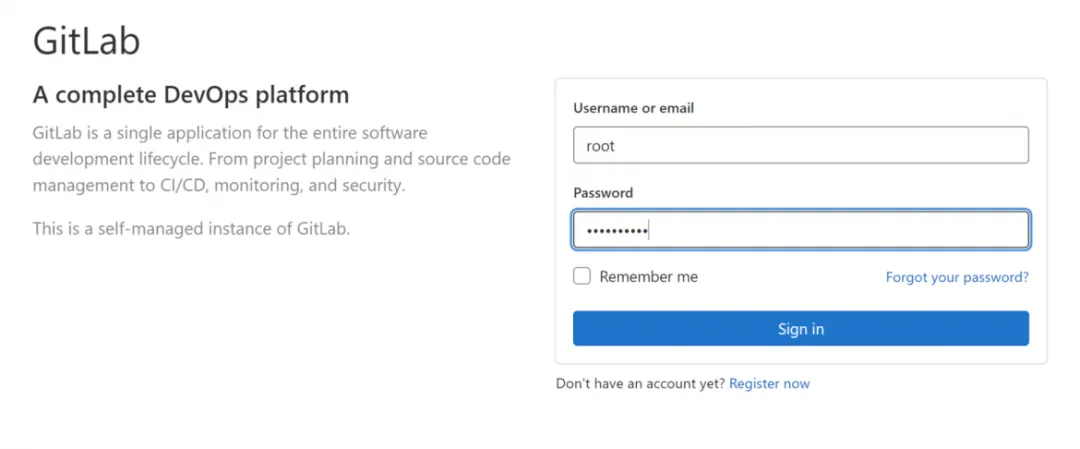任何环境的变化都可能带来风险。然而,在新版本的操作系统上运行管理和外围服务有助于建立组织内部的知识和信心。通过在红帽企业Linux (RHEL) 系统的全面支持阶段(即十年支持生命周期的前五年)使用,将享受到应有的全面支持体验。将应用和服务迁移到RHEL上尽早进行,做起来也很简单。
本文,我将演示在RHEL 9系统上部署GitLab有多么容易。除了使用新版本的RHEL外,我还将展示如何使用Ansible将部署过程自动化。这意味着将来,您可以使用Ansible自动化将GitLab部署到发布的新版本RHEL上。
一、创建Ansible角色
首先,根据GitLab的安装说明设置一个安装GitLab的角色。以下是角色中包含的目录和文件的列表:
install_gitlab
├── defaults
│ └── main.yml
├── handlers
│ └── main.yml
├── tasks
│ ├── install-gitlab.yml
│ ├── install-prerequisites.yml
│ ├── main.yml
│ ├── set-ce-edition.yml
│ ├── set-ee-edition.yml
│ └── setup-gitlab-repo.yml
└── templates
└── gitlab.repo.j2
二、创建Ansible任务
有5个任务文件,从main.yml开始:
---
- name: set vars for community edition
ansible.builtin.include_tasks:
file: set-ce-edition.yml
when:
- gitlab_edition == 'community'
- name: set vars for enterprise edition
ansible.builtin.include_tasks:
file: set-ee-edition.yml
when:
- gitlab_edition == 'enterprise'
- name: import pre-tasks
ansible.builtin.import_tasks: install-prerequisites.yml
- name: setup gitlab repo
ansible.builtin.import_tasks: setup-gitlab-repo.yml
- name: install gitlab
ansible.builtin.import_tasks: install-gitlab.yml
主任务文件控制流程,并导入其他任务文件。首先,任务文件评估要部署的GitLab版本,社区版本(CE)或企业版(EE),然后设置适当的变量。
接下来的一组任务文件根据目标GitLab版本定义一些变量。我正在使用社区版,但同时包含两个版本以供您参考。这是 set-ce-edition.yml 文件的内容:
---
- name: set CE vars
ansible.builtin.set_fact:
edition_abbreviation: ce
gitlab_package: gitlab-ce
set-ee-edition.yml文件具有完全相同的逻辑,但是它指的是企业版:
---
- name: set EE vars
ansible.builtin.set_fact:
edition_abbreviation: ee
gitlab_package: gitlab-ee
接下来,在install-prerequisites.yml文件中处理一些GitLab的先决条件:
---
- name: install prerequisites
ansible.builtin.yum:
name:
- yum-utils
- policycoreutils
- openssh-server
- openssh-clients
- postfix
register: packages_installed
- name: start/enable services
ansible.builtin.systemd:
name: "{{ service }}"
enabled: yes
state: started
loop_control:
loop_var: service
loop:
- sshd
- postfix
when:
- packages_installed.changed
很可能已经安装了一些先决条件的软件包,但是Ansible会跳过在给定系统上不需要的步骤。
接着,使用setup-gitlab-repo.yml文件在系统上设置GitLab的软件包仓库。
---
- name: push gitlab repo file
ansible.builtin.template:
src: templates/gitlab.repo.j2
dest: "/etc/yum.repos.d/gitlab_gitlab-{{ edition_abbreviation }}.repo"
owner: root
group: root
mode: '0644'
register: repo_file_pushed
- name: clear yum cache
ansible.builtin.shell:
cmd: yum clean all
when:
- repo_file_pushed.changed
最后,使用install-gitlab.yml文件安装GitLab:
---
- name: install gitlab
ansible.builtin.yum:
name: "{{ gitlab_package }}"
environment:
EXTERNAL_URL: "https://{{ inventory_hostname }}"
GITLAB_ROOT_PASSWORD: "{{ gitlab_admin_password }}"
notify:
- setup_api_token
在这个文件中,创建了一些环境变量供GitLab使用,这样在RPM事务完成后就不需要重新配置应用。
三、默认值和模板
为了支持这些Ansible任务,需要设置一些其他的东西。
默认值:默认值通常被设置为最后的备选值。这意味着只要变量在其他地方没有被覆盖,就会使用默认值。对于这个角色,设置GitLab版本的默认值。在许多其他具有更高优先级的位置可以定义它,但在这里定义它是有效的。
---
gitlab_edition: 'community'
模板:为GitLab仓库设置一个名为gitlab.repo.j2的模板:
[gitlab_gitlab-{{ edition_abbreviation }}]
name=gitlab_gitlab-{{ edition_abbreviation }}
baseurl=https://packages.gitlab.com/gitlab/gitlab-{{ edition_abbreviation }}/el/8/$basearch
repo_gpgcheck=1
gpgcheck=1
enabled=1
gpgkey=https://packages.gitlab.com/gitlab/gitlab-{{ edition_abbreviation }}/gpgkey
https://packages.gitlab.com/gitlab/gitlab-{{ edition_abbreviation }}/gpgkey/gitlab-gitlab-{{ edition_abbreviation }}-3D645A26AB9FBD22.pub.gpg
sslverify=1
sslcacert=/etc/pki/tls/certs/ca-bundle.crt
metadata_expire=300
[gitlab_gitlab-{{ edition_abbreviation }}-source]
name=gitlab_gitlab-{{ edition_abbreviation }}-source
baseurl=https://packages.gitlab.com/gitlab/gitlab-{{ edition_abbreviation }}/el/8/SRPMS
repo_gpgcheck=1
gpgcheck=1
enabled=1
gpgkey=https://packages.gitlab.com/gitlab/gitlab-{{ edition_abbreviation }}/gpgkey
https://packages.gitlab.com/gitlab/gitlab-{{ edition_abbreviation }}/gpgkey/gitlab-gitlab-{{ edition_abbreviation }}-3D645A26AB9FBD22.pub.gpg
sslverify=1
sslcacert=/etc/pki/tls/certs/ca-bundle.crt
metadata_expire=300请注意,这个模板中硬编码了数字8,因为GitLab目前尚未为RHEL 9设置仓库。将来,可以用Ansible变量替换它,比如{{ ansible_distribution_major_version }}。
处理程序:在GitLab正常运行之后,我喜欢使用个人访问令牌启用API访问。因为您正在安装一个全新的实例,可以在处理程序文件中添加一个任务,为根用户设置访问令牌:
---
- name: set access token for API access
ansible.builtin.shell:
cmd: >
gitlab-rails runner "token = User.find_by_username('root').personal_access_tokens.create(scopes: [:api], name: 'Ansible Automation token'); token.set_token('{{ gitlab_admin_password }}'); token.save!"
register: token_create_output
listen:
- setup_api_token
设置此令牌允许通过GitLab的API或使用community.general中的Ansible模块进行配置,一旦此角色成功运行。
角色现在已经完成。快速编写一个playbook,并将其保存为???.yml:
---
- name: install gitlab
hosts:
- all
roles:
- roles/install_gitlab
创建一个清单文件,将Ansible指向我们的RHEL9系统,并将其保存为???.ini:
---
all:
children:
gitlab:
hosts:
gitlab.example.com:
ansible_user: tux
ansible_password: 'change_me'
ansible_become: yes
ansible_become_password: 'change_me'
gitlab_admin_password: 'change_me'
四:运行Playbook
一切准备就绪。现在是时候运行您的Ansible Playbook了:
当Playbook完成后,访问新GitLab实例的网址,并使用管理员密码登录。

总结:您刚刚使用Ansible在RHEL 9系统上安装了GitLab!尽管这是一个简单直接的过程,但已经完成了一些重要的步骤。您开发了一个可重复使用的Ansible角色,在RHEL的主要版本之间可以轻松移植,而且几乎不需要修改。还将一个重要的工作负载放在了全球top的企业Linux平台的新版本上:红帽企业Linux。
内容来源于:在RHEL 9上使用Ansible安装GitLab CE
 483
483 0
0